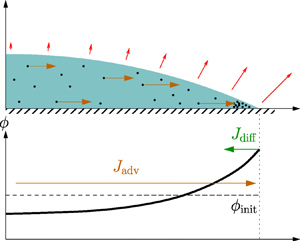Crossref Citations
This article has been cited by the following publications. This list is generated based on data provided by
Crossref.
Hennessy, Matthew G.
Craster, Richard V.
and
Matar, Omar K.
2022.
Drying-induced stresses in poroelastic drops on rigid substrates.
Physical Review E,
Vol. 105,
Issue. 5,
Moore, Madeleine Rose
Vella, D.
and
Oliver, J.M.
2022.
The nascent coffee ring with arbitrary droplet contact set: an asymptotic analysis.
Journal of Fluid Mechanics,
Vol. 940,
Issue. ,
Larsson, Christopher
and
Kumar, Satish
2022.
Quantitative analysis of the vertical-averaging approximation for evaporating thin liquid films.
Physical Review Fluids,
Vol. 7,
Issue. 9,
Yuvan, Steven
and
Bier, Martin
2022.
Accumulation of Particles and Formation of a Dissipative Structure in a Nonequilibrium Bath.
Entropy,
Vol. 24,
Issue. 2,
p.
189.
Li, Yaxing
Lv, Pengyu
Diddens, Christian
and
Lohse, Detlef
2022.
Physiochemical hydrodynamics of the phase segregation in an evaporating binary microdroplet.
Journal of Fluid Mechanics,
Vol. 946,
Issue. ,
Mailleur, Alexandra
Pirat, Christophe
Simon, Gilles
Fulcrand, Rémy
and
Colombani, Jean
2022.
Ring shells obtained from pure water drops evaporating on a soluble substrate.
Colloids and Surfaces A: Physicochemical and Engineering Aspects,
Vol. 651,
Issue. ,
p.
129724.
Zheng, Zhong
2023.
Accumulation of Particles Towards the Envelope of a Fluid-Infused Patch Under Evaporation.
SIAM Journal on Applied Mathematics,
Vol. 83,
Issue. 3,
p.
1245.
Mathijssen, Arnold J. T. M.
Lisicki, Maciej
Prakash, Vivek N.
and
Mossige, Endre J. L.
2023.
Culinary fluid mechanics and other currents in food science.
Reviews of Modern Physics,
Vol. 95,
Issue. 2,
Larsson, Christopher
and
Kumar, Satish
2023.
Comparison of one-sided and diffusion-limited evaporation models for thin liquid droplets.
Journal of Fluid Mechanics,
Vol. 976,
Issue. ,
D'Ambrosio, Hannah-May
Wilson, Stephen K.
Wray, Alexander W.
and
Duffy, Brian R.
2023.
The effect of the spatial variation of the evaporative flux on the deposition from a thin sessile droplet.
Journal of Fluid Mechanics,
Vol. 970,
Issue. ,
Moore, Madeleine R.
and
Wray, Alexander W.
2023.
Gravitational effects on coffee-ring formation during the evaporation of sessile droplets.
Journal of Fluid Mechanics,
Vol. 967,
Issue. ,
Wilson, Stephen K.
and
D'Ambrosio, Hannah-May
2023.
Evaporation of Sessile Droplets.
Annual Review of Fluid Mechanics,
Vol. 55,
Issue. 1,
p.
481.
Wray, Alexander W.
and
Moore, Madeleine R.
2023.
Evaporation of non-circular droplets.
Journal of Fluid Mechanics,
Vol. 961,
Issue. ,
Xiong, Hongbing
Wang, Qichao
Yuan, Lujie
Liang, Junkai
and
Lin, Jianzhong
2023.
Modeling and Experiments of Droplet Evaporation with Micro or Nano Particles in Coffee Ring or Coffee Splat.
Nanomaterials,
Vol. 13,
Issue. 10,
p.
1609.
Bhatt, Sheila J.
and
Routh, Alexander F.
2024.
Optical absorbance profilometry for tracking time-resolved particle redistribution in high volume fraction colloidal droplets.
Scientific Reports,
Vol. 14,
Issue. 1,
Wray, Alexander W.
and
Moore, Madeleine R.
2024.
High-order asymptotic methods provide accurate, analytic solutions to intractable potential problems.
Scientific Reports,
Vol. 14,
Issue. 1,
Varley, Thomas S.
Lawrence, Nathan S.
and
Wadhawan, Jay D.
2024.
Electrochemical goniometry: keystone reactivity at the three-phase boundary.
Journal of Solid State Electrochemistry,
Coombs, Nathan C. J.
Sprittles, James E.
and
Chubynsky, Mykyta V.
2024.
Colloidal deposits from evaporating sessile droplets: Coffee ring versus surface capture.
Physical Review Fluids,
Vol. 9,
Issue. 6,
Luckins, Ellen K.
Breward, Christopher J.W.
Griffiths, Ian M.
and
Please, Colin P.
2024.
Mathematical modelling of impurity deposition during evaporation of dirty liquid in a porous material.
Journal of Fluid Mechanics,
Vol. 986,
Issue. ,
Li, Weibin
Zhang, Chen
and
Wang, Yuren
2024.
Evaporative self-assembly in colloidal droplets: Emergence of ordered structures from complex fluids.
Advances in Colloid and Interface Science,
Vol. 333,
Issue. ,
p.
103286.




